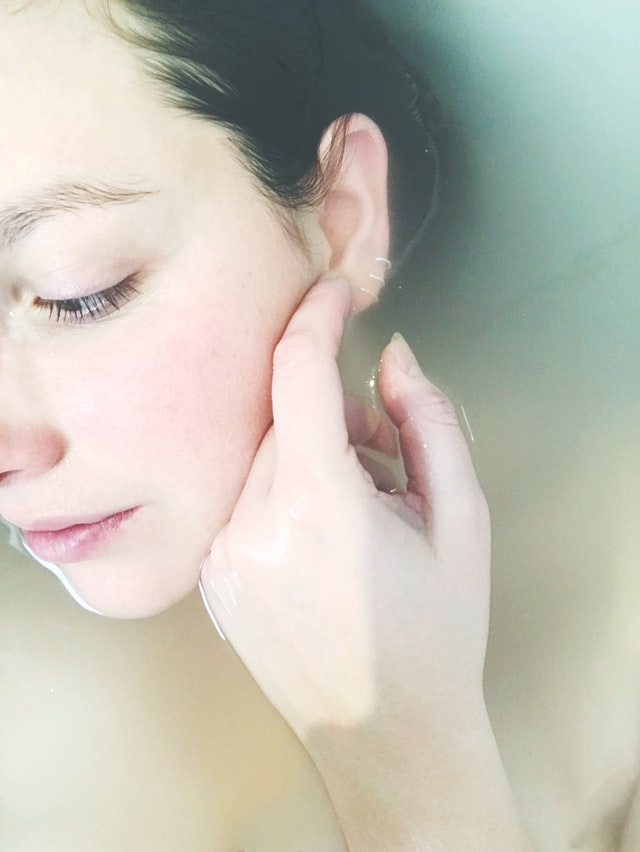You've spent the day outdoors, and now your skin is paying the price – it's red, hot, and tender to the touch. To calm the redness and soothe your sun-damaged skin, you'll need to follow a gentle after-sun care routine. You'll want to start by applying soothing products that are rich in aloe vera, cucumber, and green tea. But that's just the beginning. There are several key steps you can take to reduce inflammation, replenish moisture levels, and support skin health. The question is, where do you start, and what products and techniques will give you the best results?
Soothe and Cool Your Skin
After spending time in the sun, you'll want to calm your skin with soothing products that help reduce heat and inflammation, promoting a faster recovery. You'll be on the lookout for ingredients like aloe vera, cucumber, and green tea, which are known for their anti-inflammatory and cooling properties. Apply a soothing after-sun lotion or cream to the affected areas, making sure to cover all exposed skin.
As you gently massage the product into your skin, you'll start to feel the heat dissipate, replaced by a calming coolness. Your skin will begin to relax, reducing redness and irritation. This is especially important if you've experienced sunburn, as it will help prevent further damage and promote healing. By taking the time to soothe and cool your skin after sun exposure, you'll be taking the first step towards a faster recovery and healthier, more resilient skin. Your skin will thank you for the extra TLC, and you'll be able to enjoy the sun with confidence.
Cleanse Gently After Sun Exposure
Once you've soothed and cooled your skin, it's time to gently wash away the day's sweat, sunscreen, and impurities that can clog pores and cause irritation, setting your skin up for a healthy recovery. You'll want to cleanse your skin as soon as possible after sun exposure to prevent dirt and bacteria from settling in. Opt for a gentle, fragrance-free cleanser that's formulated for your skin type, and massage it onto your skin in a circular motion. Avoid using harsh exfoliating scrubs or astringent products, which can strip your skin of its natural oils and cause further irritation.
Use lukewarm water to rinse your skin, making sure to remove all soap residue. Pat your skin dry with a clean towel – don't rub, as this can irritate your skin further. Be gentle around sensitive areas, such as the skin around your eyes and mouth. By cleansing your skin gently and effectively, you'll help to calm redness, reduce inflammation, and create a smooth canvas for the next steps in your after-sun skincare routine. Remember, gentle cleansing is key to supporting your skin's natural recovery process.
Apply After-Sun Care Products
Gently applying specially formulated after-sun care products helps your skin recover from the damaging effects of UV exposure and supports its natural repair process. When you use these products, you're providing your skin with essential nourishment and hydration. Look for products that are rich in soothing ingredients and antioxidants, as these help neutralize free radicals caused by UV radiation. Apply them generously to all exposed areas, making sure to cover every inch of skin that's been in the sun.
As you massage these products into your skin, you'll start to feel the soothing effects immediately. Your skin will begin to calm and relax, reducing that tight, hot sensation that often comes with sun exposure. By regularly using these after-sun care products, you'll be supporting your skin's health, providing it with what it needs to repair damaged skin cells and regain its natural barrier function. This helps to maintain the overall well-being and appearance of your skin, keeping it healthy, smooth, and radiant.
Use Anti-Inflammatory Ingredients
Many anti-inflammatory ingredients, such as aloe vera, chamomile, and green tea extract, can be used to help reduce redness and swelling caused by sun exposure. You can find these ingredients in various after-sun care products, like creams, gels, and serums. When you apply these products to your skin, they'll help calm the inflammation and alleviate discomfort.
You can also use cool compresses or cold packs to enhance the anti-inflammatory effects of these ingredients. Simply wet a cloth with cold water, wring it out, and apply it to the affected area for a few minutes. This will help constrict blood vessels and reduce swelling. Alternatively, you can soak a cloth in a cooled tea, such as green tea or chamomile tea, and apply it to your skin. The antioxidants and anti-inflammatory compounds in the tea will help soothe and calm your skin. By incorporating anti-inflammatory ingredients into your after-sun care routine, you'll be able to reduce redness and swelling more effectively.
Hydrate Your Skin Intensively
To counteract the drying effects of the sun, you'll need to replenish your skin's moisture levels with intense hydration. This is achieved by using products loaded with humectants and emollients. Humectants, such as hyaluronic acid and glycerin, help retain moisture in the skin, while emollients like ceramides and niacinamide fill gaps between skin cells, making it smoother and softer.
You can apply hydrating serums or creams multiple times a day, depending on your skin's needs. Look for products labeled 'intensive' or 'long-lasting' hydration to give your skin the boost it needs after a day in the sun. Additionally, you can use hydrating face masks once or twice a week to provide an extra dose of moisture. When applying your hydrating products, gently massage them into your skin to help stimulate blood flow and promote better absorption. By intensively hydrating your skin, you'll not only counteract dryness but also help reduce irritation and redness caused by the sun. This sets the stage for the next steps in your after-sun skin care routine, helping your skin recover more efficiently.
Avoid Harsh Skin Care Products
After intensively hydrating your skin, you'll want to steer clear of harsh skin care products that can strip it of its newly replenished moisture and cause further irritation. Switch to gentle, fragrance-free cleansers that won't strip your skin of its natural oils. Avoid products containing exfoliating beads, alpha-hydroxy acids (AHAs), or beta-hydroxy acids (BHAs), as they can be too harsh on sensitive, sun-kissed skin.
You'll also want to avoid using astringent toners, which can dry out your skin even more. Instead, use a gentle toner that helps balance your skin's pH level. Be gentle when washing your face, and avoid using hot water, which can strip your skin of its moisture. Use lukewarm water instead, and pat your face dry with a towel. By being gentle with your skin and avoiding harsh products, you can help it recover from sun damage and reduce redness and irritation. This simple tweak to your skin care routine can make a big difference in how your skin feels and looks.
Help Your Skin Regenerate
By giving your skin the right nourishment, you can help trigger its natural regeneration process and repair damaged skin cells. After a long day in the sun, your skin is craving extra attention. You can give it the TLC it needs by applying a rich, hydrating moisturizer that's packed with antioxidants and soothing ingredients. Look for a product that contains hyaluronic acid, ceramides, or niacinamide, which can help lock in moisture and support the skin's barrier function.
As you apply the moisturizer, gently massage it into your skin using circular motions. This will help increase blood flow and promote collagen production, which can aid in the regeneration process. Don't forget to pay special attention to areas that got the most sun exposure, such as your face, neck, and ears. By taking the time to nourish and care for your skin, you can help it recover from the sun's harsh effects and get back to its healthy, radiant self. With consistent effort, your skin will start to look and feel smoother, softer, and more even-toned.
Reduce Redness and Itching
Your skin's natural response to excessive sun exposure may include redness and itching, but you can take steps to alleviate these uncomfortable symptoms. To reduce redness, apply a cooling gel or cream that contains ingredients like aloe vera, chamomile, or green tea. These natural soothing agents will help calm your skin and bring down the redness.
For itching, try using a gentle, fragrance-free moisturizer that won't irritate your skin further. Look for products containing ceramides, hyaluronic acid, or niacinamide, which can help repair and lock in moisture. Apply the moisturizer while your skin is still damp to help it absorb more effectively. You can also use over-the-counter hydrocortisone cream to reduce inflammation and itching. Just be sure to follow the instructions and use it for a limited period.
In addition to topical treatments, take cool baths or showers to help bring down the redness and itching. Avoid harsh soaps, exfoliants, and hot water, which can strip your skin of its natural oils and make the symptoms worse. By taking these steps, you can help your skin feel more comfortable and reduce the redness and itching caused by excessive sun exposure.
Prevent Future Sun Damage
Shielding your skin from the sun's damaging rays is crucial, so make preventing future sun damage a priority by incorporating a few simple habits into your daily routine. You'll want to start by applying a broad-spectrum sunscreen with at least SPF 30 every morning, even on cloudy days. Don't forget to reapply it every two hours or immediately after swimming or sweating.
In addition to sunscreen, you can also wear protective clothing, such as a wide-brimmed hat and long-sleeved shirt, when spending time outdoors. Seek shade, especially during peak sun hours (10am-4pm), and avoid reflective surfaces like water and sand that can increase your exposure to the sun's rays.
You can also take steps to protect your skin from the inside out. Eating a diet rich in antioxidants, such as berries and leafy greens, can help combat sun damage. Staying hydrated by drinking plenty of water can also help keep your skin healthy and resilient. By making these habits a part of your daily routine, you'll be well on your way to preventing future sun damage and maintaining healthy, glowing skin.
At a Glance
You've got the essentials to calm redness and soothe sun-damaged skin. Stick to a gentle after-sun care routine that cools, hydrates, and regenerates your skin. Remember to use soothing products, avoid harsh ingredients, and protect yourself from future sun damage. By following these steps, you'll be on your way to healthier, happier skin. Don't wait until it's too late – start your after-sun care routine today and give your skin the TLC it deserves. Consider incorporating aloe vera gel or a soothing moisturizer with ingredients like cucumber or chamomile to help calm and heal sun-damaged skin. Additionally, regular use of sunscreen with a high SPF can protect your skin from further damage. If you’re looking to address any existing sun damage, you may also want to explore the laser skin resurfacing benefits, which can help improve skin texture and reduce redness caused by sun exposure. Taking care of your skin now will not only soothe current damage but also prevent future issues.






